人教版八年级英语下册unit1-what's-the-matter-1a-1c说课稿复习课程
人教新版英语八年级下册Unit-1-What’s-the-matter第一单元导学案
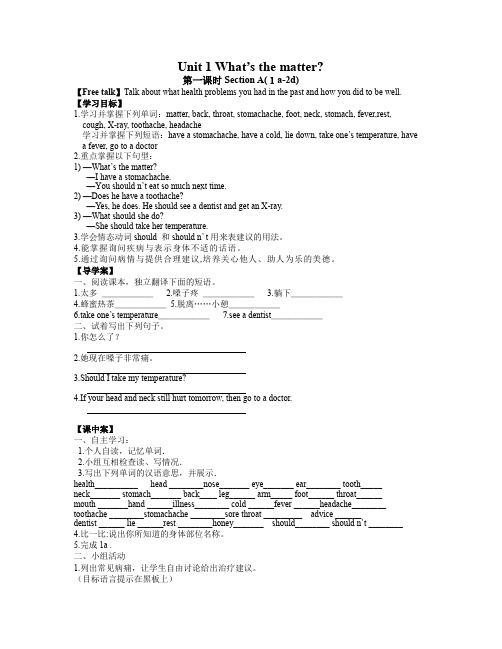
Unit 1 What’s the matter?第一课时Section A(1a-2d)【Free talk】Talk about what health problems you had in the past and how you did to be well. 【学习目标】1.学习并掌握下列单词:matter, back, throat, stomachache, foot, neck, stomach, fever,rest, cough, X-ray, toothache, headache学习并掌握下列短语:have a stomachache, have a cold, lie down, take one’s temperature, havea fever, go to a doctor2.重点掌握以下句型:1) —What’s the matter?—I have a stomachache.—You should n’t eat so much next time.2) —Does he have a toothache?—Yes, he does. He should see a dentist and get an X-ray.3) —What should she do?—She should take her temperature.3.学会情态动词should 和should n’ t用来表建议的用法。
4.能掌握询问疾病与表示身体不适的话语。
5.通过询问病情与提供合理建议,培养关心他人、助人为乐的美德。
【导学案】一、阅读课本,独立翻译下面的短语。
1.太多______2.嗓子疼______3.躺下______4.蜂蜜热茶______5.脱离……小憩______6.take one’s temperature______7.see a dentist______二、试着写出下列句子。
人教版八年级英语下册《Unit 1 Unit 1 What’s the matter?》教案.doc
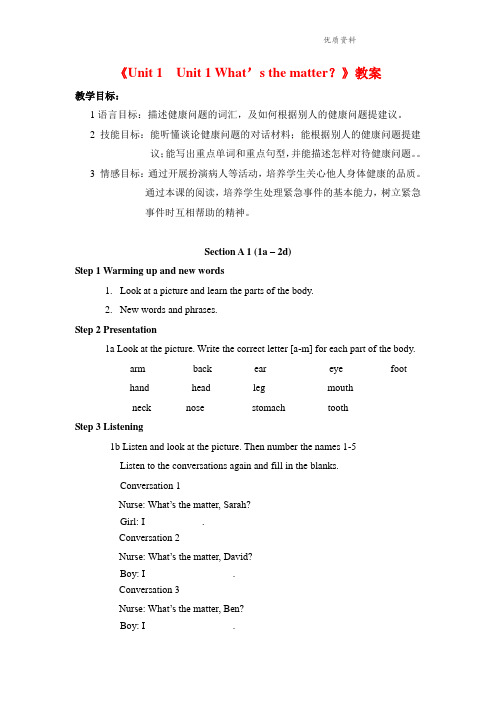
《Unit 1 Unit 1 What’s the matter?》教案教学目标:1语言目标:描述健康问题的词汇,及如何根据别人的健康问题提建议。
2 技能目标:能听懂谈论健康问题的对话材料;能根据别人的健康问题提建议;能写出重点单词和重点句型,并能描述怎样对待健康问题。
3 情感目标:通过开展扮演病人等活动,培养学生关心他人身体健康的品质。
通过本课的阅读,培养学生处理紧急事件的基本能力,树立紧急事件时互相帮助的精神。
Section A 1 (1a – 2d)Step 1 Warming up and new words1.Look at a picture and learn the parts of the body.2.New words and phrases.Step 2 Presentation1a Look at the picture. Write the correct letter [a-m] for each part of the body.___arm ___ back ___ ear ___ eye ___ foot___hand ___ head ___ leg ___ mouth___ neck ___nose ___ stomach ___ toothStep 3 Listening1b Listen and look at the picture. Then number the names 1-5Listen to the conversations again and fill in the blanks.Conversation 1Nurse: What’s the matter, Sarah?Girl: I ___________.Conversation 2Nurse: What’s the matter, David?Boy: I _________________.Conversation 3Nurse: What’s the matter, Ben?Boy: I _________________.Conversation 4Nurse: What’s the matter, Nancy?Girl: I _________________.Conversation 5Betty: What’s the matter, Judy?Ann: She __________________.Step 4 Speaking1c Look at the pictures. What are the students’ problems? Make conversati ons.ExamplesA: What’s the matter with Judy?B: She talked too much yesterday and didn’t drink enough water.She has a very sore throat now.A: What’s the matter with Sarah?B: She didn’t take care of herself on the weekend. She was p laying withher friends at the park yesterday. Then it got windy, but she didn’t puton her jacket. Now she has a cold.Step 5 Guessing gamesGuess what has happened to the students by using the important sentenc es. Step 6 Listening2a Listen and number the pictures [1-5] in the order you hear them.2b Listen again. Match the problems with the advice.Step 7 Speaking2c Make conversations using the information in 2a and 2bA: What’s the matter?B: My head feels very hot.A: Maybe you have a fever.B: What should I do?A: You should take your temperature.Step 8 Role–playImagine you are the school doctor. A few students have health problems.Role-play a conversation between the doctor and the students.2d Role –play the conversationStep 9 Language points and summary1. What’s the matter?这是人们特别是医生和护士询问病人病情时最常用的问句, 意思是“怎么了?”其后通常与介词with连用。
人教版八年级英语下册Unit 1 What’s the matterSection B (1a-1d
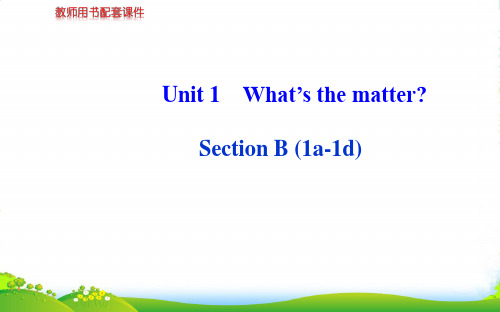
1. If you have a
, you should put your head back.
2. Bob hurt
in P. E. class and he couldn’t move.
3. She
her finger while getting ready for the supper
yesterday.
What happened? 发生了什么事? 【自主领悟】 happen意为“发生”, 为不及物动词, 常表示某事发生的偶然 性。例如: On their way to work, they saw an accident happen on the street. 在上班的路上, 他们看到街上发生了一起事故。
【活学活用】
①—What happened
Mr. Smith yesterday?
—He fell down and hurt his leg.
A. to
B. on
②Great changes have
C. with
D. for
in my hometown these years.
A. happen
(3)“sb. +happen+ _t_o_d_o_sth. ”意为“某人碰巧做某事”。 例如: I happened to meet an old friend of mine in the street yesterday. 昨天我在街上碰巧遇到了一位老朋友。
【误区警示】 (1)happen为不及物动词, 不能用于被动语态。 (2)happen为短暂性动词, 不能与表示一段时间的状语连用。 (3)happen一般用来强调某事发生的偶然性。如要表示事先 安排或有准备的事情或活动, 则不能用happen, 而要用 _ta_k_e__p_la_c_e_。
人教版英语八年级下册Unit1What’s the matterSection A 1a-1c课件

手臂
背部
耳朵
_i_ eye _b_ foot _a_ hand
眼睛
_j_ head
脚(复数feet) 手
_l_ leg _c_ mouth
头
腿
嘴
_d_ neck m__nose _k_ stomach
脖颈 鼻子 胃;腹部
_f_ tooth
牙齿(复数:teeth)
What’s the matter with him/her?
Homework
1. 听力材料抄一遍 2. U1单词matter-hurt,三英一汉抄一遍。
for the first time. 8. If you agree, you can nod(点头) your _h_e_a_d_.
Learning Goals: 1、听录音, 完成相应练习; 2、翻译听力材料,熟读并role-play; 3、能用英语谈谈自己哪里不舒服:
—What’s the matter? —I have a cold.
have a cold 得了流感
have a sore back 背疼
What’s the matter with him/her?
get a stomachache 胃痛
have a toothache 牙疼
What’s the matter with him/her?
have a fever 发烧
New words
matter sore stomachache foot neck
n. 问题;事情 adj. 疼痛的;酸痛的 n.胃痛;腹痛 n. 脚;足 n. 颈;脖子
stomach throat fever lie rest cough
人教版八年级英语下册电子教材-2022年学习材料
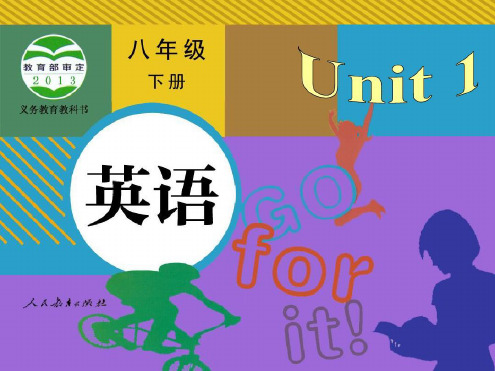
Guessing-What's the matter with-him?-Does he have a f ver?-Does he have a toothache?-What should he do?-V四o om-居酒网
What's the matter with-him?-Does he have a fever?-Doe he have a toothache?-What should he do?-管四om -居酒网
Listen to the conversations again-and fill in the bla ks.-Conversation 1-Nurse:What's the matter,Sarah?-Gir :I have a cold.-Conversation 2-Nurse:What's the matte ,David?-Boy:I got a stomachache.-Conversation 3-Nurse What's the matter,Ben?-Boy:I haye a sore back.
1a Look at the picture.Write the correct-letter [a-m or each part of the body.-have a sore back.-What's th -matter?-二-工have a cold-I have a-stomachache.-h arm-_ back-g-ear-ieye h foot-a hand-_jhead--1 leg-c_mouthneck-m nose-k stomach-f tooth
2b Listen again.Match the-problems with the advice.-f ver-a lie down and rest-2 stomachache-b drink some ho tea-with honey-3 cough and sore throat c see a denti t and-get an X-ray-4 toothache-d take your temperatur -5 cut myself-e put some medicine on it
人教版 八年级英语 下册 Unit1_what's_the_matter课件(完整)

Conversation 4 Girl :What’s wrong with your face? Boy: It’s not my face.It’s my tooth.I have a toothache. Girl:You should see a dentist and get an X-ray. Boy:But will it hurt? Girl:No,and if you don’t go to the dentist now,it’ll hurt even more later!
night,I got a stomachache. I almost couldn’t get myself out of bed this morning.
Conversation 3 Nurse:What’s the matter,Ben?Can you move? Ben:Not really.I was playing soccer the other day and I hurt myself.It
foot n. 脚;足 neck n. 颈;脖子
Words and expressions
stomach n. 胃;腹部 throat n. 咽喉;喉咙 fever n. 发烧 lie v.躺;平躺
lie down 躺下 rest v. 放松;休息
cough v. 咳嗽 X-ray n. X射线;X光
Lisa: OK. Thanks, Mandy.
3b Read the passage again and check the things that happened in the story.
Unit+1+What’s+the+matter课件-2024-2025学年人教版八年级英语下册
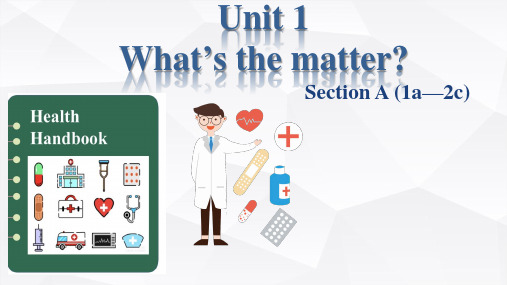
Homework
If you can: Be a health helper.Care about
students who have health problems
and give them some proper advice in
You must:
English.
1.Read the tape- scripts
Listen and number the pictures(1-5) in the order you hear them.
2 3
4
1
5
Listen and match the problems with the advice.
Problems
1.fever
Advice
a. lie down and rest
Watch a video.
Game time: Act and guess
have a headache /ˈhedeɪk/
have a toothache /ˈtuːθeɪk/
have a stomachache /'stʌməkeɪk/
have a cough /kɒf/
have a fever
Chapter III
Dangerous situation Self-protection Spirit
Chapter IV
Practical Activities
Name Problem
Listen and write down their problems.
Sarah has a _c_o_l_d______
A:What’s the matter with...?
人教版八年级英语下册Unit1 What's the matter全单元课件

3. Do you think it comes from a newspaper or a book?
你认为它是来自报纸还是书呢?
4. I think I sat in the same way for too long without
moving. 我想我以同样的姿势一动不动地坐得太久了。
44. be used to doing sth. 习惯做某事 45. run out (of) 用完;用尽 46. so that 以便 47. so. . . that 如此… …以至于… 48. be in control of 掌管;管理 49. in a d iffic u lt situation 在闲境屮 50. keep on doing sth. 继续或坚持做某事 51. make a decision 做出决定 52. take risks 冒险 53. give up 放弃
2.能运用情态动词should句型给出建议。 3. 正确使用反身代词。
Section A 1a-2d
body
tooth
feet
teeth
nose faceear
toe
neck
face
lห้องสมุดไป่ตู้g
heel
elbow
sing a song
1a Look at the picture. Write the correct letter[a—m] for each part of the body.
__k__arm __c__back _g___ear _i___eye _m___foot __a__hand_l___head b____leg _f___mouth ___d_neck _j___nose __h__stomach _e___tooth
人教版八年级下册Unit-1-What's-the-matter单元知识点

Unit 1 What’s the matter?一、基本知识点1. What’s the matter (with you)? 怎么了?出什么事了?What’s the trouble/ the problem / wrong with sb./ sth.?2. I had a cold.我感冒了。
have a cold=catch a cold=have the flu have a fever have a cough咳嗽have a stomachache胃疼,肚子疼 have a toothache牙疼 have a headache头疼3. 身体部位+ache(疼痛)构成新的复合词stomach+ache=stomachache head+ache=headache tooth+ache=toothache back+ache=backache后背痛4. much too+ 词,意为,too much+ 词,意为。
5. enough【形容、副词】足够的/地,enough放在名前后,形副后。
good enough足够好,enough money=money money6. lie down躺下, lie 躺,躺着,过去式lay;lie说谎,过去式lied7. maybe “或许”,常用于句首,表示可能性,后加句子。
Maybe you are right.may be,是情态动词+be的结构,意为“可能,也许”,后加名词、代词或形容词。
He may be angry.8. sound like+名词代词和从句:It sounds like you don’t know the truth. It sounds like a good idea.sound+形容词,“听起来,好像”,The music sounds nice.9. need 需要,实义动词need+名词,需要某物;need to do sth.需要做某事,主语通常是人,表示人主动的动作:You need to listen carefully during class.need doing sth.主语通常是物,表示被动的动作:Your dirty clothes need washing.10. get off (the bus) 下(公交车) get on 上车11. agree 同意,赞同;同意做某事,同意某人的看法、观点。
英语人教版八年级下册第一单元What’s-the-matter
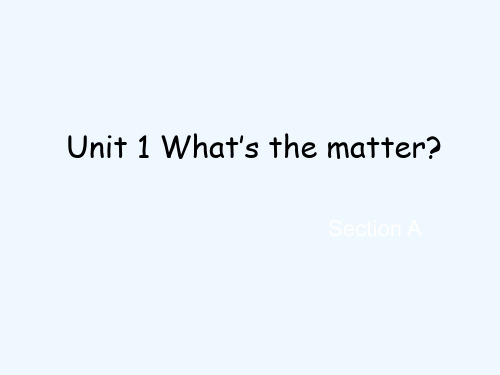
A: What’s the matter? B: I’m not feeling well.
I have a fever. A: When did it start? B: About two days ago. A: Oh, that’s too bad.
Unit 1 What’s the matter?
Section A
body
Name each part of the body
arm
ear
eye foot
leg hand
mouth
nose
tooth
neck
Follow me:
• Everybody moves your body • Nod your head and touch your face • Touch your nose and close your eyes • Touch your ears and clap your hands • Raise your arms and look at your back • Touch your stomach and tap your foot • Sit down and move your legs
What should she do? She should take some medicine.
What’s the matter with you? I have a toothache. You should see a dentist. That’s a good idea.
What’s the matter with her? She has a sore throat. What should she do?
英语人教版八年级下册Unit1What's-the-matter课件

cut oneself
Where are they? Who is she?
Do they look well?
Look at the picture and answer the questions.
1b. Listen and look at the picture. Then number the names [1-5].
A:What’s the matter with you ?
B:I have a cough and sore throat
A:You should drink some hot tea with honey.
A:What’s the matter with you ?
B:I cut myself by accident.
.
Pair work
A: What’s the matter? A:I have a……stay in bed . B:You should
have a good rest. lie down and rest. see a dentist and get an X-ray. drink lots of water. drink hot tea with honey take some medicine. take your temperature ……….
Advice: What should they do?
对 症 下 药
stomachache
fever
toothache
sore throat
A:What’s the matter? stomachache B:I have a _____________.
lie down and have a rest A:You should_______________________.
新人教版初二下册英语知识点归纳-Unit-1-What’s-the-matter
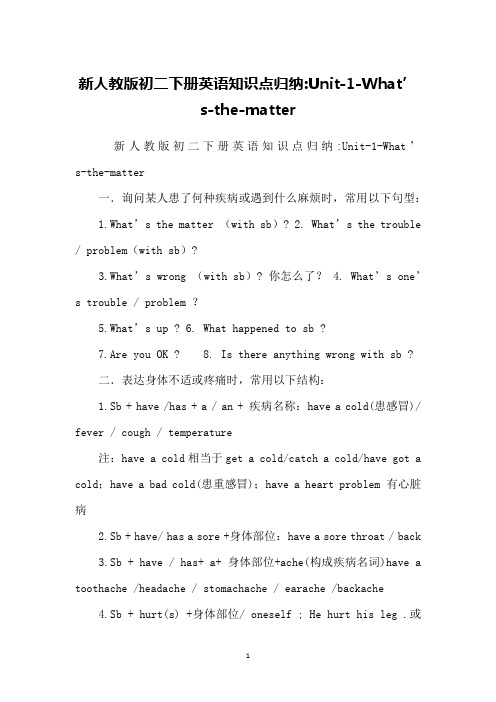
新人教版初二下册英语知识点归纳:Unit-1-What’s-the-matter新人教版初二下册英语知识点归纳:Unit-1-What’s-the-matter一.询问某人患了何种疾病或遇到什么麻烦时,常用以下句型:1.What’s the matter (with sb)?2. What’s the trouble / problem(with sb)?3.What’s wrong (with sb)? 你怎么了?4. What’s one’s trouble / problem ?5.What’s up ?6. What happened to sb ?7.Are you OK ? 8. Is there anything wrong with sb ?二.表达身体不适或疼痛时,常用以下结构:1.Sb + have /has + a / an + 疾病名称:have a cold(患感冒)/ fever / cough / temperature注:have a cold相当于get a cold/catch a cold/have got a cold;have a bad cold(患重感冒);have a heart problem 有心脏病2.Sb + have/ has a sore +身体部位:have a sore throat / back3.Sb + have / has+ a+ 身体部位+ache(构成疾病名词)have a toothache /headache / stomachache / earache /backache4.Sb + hurt(s) +身体部位/ oneself ; He hurt his leg .或身体部位+ hurts ; My head hurts badly .5.There is something wrong with one’s +身体部位。
- 1、下载文档前请自行甄别文档内容的完整性,平台不提供额外的编辑、内容补充、找答案等附加服务。
- 2、"仅部分预览"的文档,不可在线预览部分如存在完整性等问题,可反馈申请退款(可完整预览的文档不适用该条件!)。
- 3、如文档侵犯您的权益,请联系客服反馈,我们会尽快为您处理(人工客服工作时间:9:00-18:30)。
人教版八年级英语下册u n i t1-w h a t's-t h e-m a t t e r-1a-1c
说课稿
尊敬的各位领导,评委老师:
大家下午好!今天我说课的内容是PEP八年级英语下册 Unit1what’s the matter?Part A( 1a-1c )部分。
下面我将从教材、学情、教法学法、教学过程和简要的板书设计及反思这六个方面展开我的说课。
一、说教材
1、教材的内容和地位
(1)教材是以“What’s the matter?为中心话题,学习谈论健康状况及如何针对身体不适问题提出建议,并倡导人们养成健康饮食及良好的生活习惯。
教育学生注意饮食习惯,关心他人。
在学习中,学生通过对身体不适的描述及建议,促进学生之间和师生之间的情感交流,增进情谊。
(2)本节是本单元的重点内容,主要学习人体各个部位名称及询问对方的身体状况,使学生学会关心他人。
2、新课标要求
新课程标准明确指出要发展学生综合运用语言的能力,培养学生的交际能力。
3、教学目标
根据教学大纲和学生的实际情况,我制定如下教学目标:
(1).知识目标:
A.识记人体各个部位的名称及如何谈论身体健康状况
B.运用”What’s the matter…?”“I have/get …”句型在日常生活中进行对话
(2).能力目标:
培养学生能运用所学语言简单的描述自己的健康状况及如何询问对方的身体健康状况。
提高学生的听、说、读综合能力。
(3)情感、态度和价值观
教育学生要学会关心他人,通过询问他人的健康情况并能给予帮助,增进人与人之间的感情。
让学生感受到学英语最主要是为了在现实生活中进行交流,而不是单纯的为了英语课和应付考试而学习。
4、教学重难点
根据教学大纲的要求,及本课在教材的地位及作用。
我确定以下重、难点:
重点:学习人体各个部位的名称及如何询问和回答身体的健康状况。
难点:有“What’s the matter?/ What’s wrong?”“I have/get a sore throat…”句型在实际生活中的应用。
二、说学情
八年级的学生对英语已经有一定的基础,但对于乡镇中学的学生来说,大部分学生学习英语的兴趣不是很浓,在学习中他们更喜欢从游戏或活动中学习。
针对这一情况,我在课堂上创造外语语言氛围,激发学生学习英语的兴趣;让学生在参与英语各项活动时,能够更好地掌握知识;同时通过对话来进行训练,巩固所学的知识。
让学生在乐中学,轻松地掌握所学知识。
三、说教法学法
作为一个引导者、组织者,我遵循新课程“学生是学习的主人,一切的教学活动设计在以学生为本”的教学理念,坚持“为学生的发展,必须培养学生的自主性、能动性、独立性和创造性”的教学原则。
课堂上我采用了多媒体、图片、和肢体动作来辅助教学,增加了直观性、活跃性和趣味性。
通过任务型教学法,,图片展示法等去引导学生学习。
学生通过在参与各种活动中学习知识。
学生在轻松的气氛里掌握知识,达到最佳的教学效果。
四、说教学过程
Step 1 Warming-up
(设计意图:让同学跟着视频音乐和里面的人物做warming-up活动,通过全方位的运动,全感官的放松,为学生创造轻松愉快的学习气氛,激发学生的好奇心,为学习新课拉开了完美的序幕。
让学生很快融入到英语学习的氛围中,同时为下面引出身体各部位名称的教学作铺垫。
)
Step 2 Word study
(设计意图:用明星的图片激发学生的兴趣,用图片来教学新的单词,直观、形象生动,有利于单词的巩固记忆。
)
Step 3 Practice
检查学生对身体部位单词的掌握情况。
Step 4 Presentation and practice
(设计意图:以happy这个单词自然地引出the wo man who’s not happy because she has a cold.为下面引出其他人的种种不适做铺垫。
)
What’s the matter? He/She has a headache/ toothache /stomachache /a sore back/ a sore throat.
(设计意图:用形象生动的图片来引出本课要掌握的句型,有利于学生对新知识的掌握。
)
3. Grammar focus.
呈现完新句型后,我把重点知识点予以整合。
(设计意图:对重难点知识提炼与整合,让学生更好的对重点知识系统性的记忆,加深印象。
)
4. Practice(对话练习)
(设计意图:以对话的形式来操练句型,巩固新句型的使用。
从第三人称过渡到第一人称,对学生来说是简单了。
)
Step 5 listening
听之前分析内容
(设计意图:作好听力前的铺垫对于学生提高正确率非常重要,所以在听前对图片和任务的分析很有必要,为学生接下来的听力任务打下了基础。
)
在整体感知后,我把听力截成五个对话部分,让学生用填空的方式完成表格,从而为下面的1c对话练习做好铺垫。
Step 6 Speaking
结合1b的表格再让学生仿照1c的例句造句,让更多的学生有表达的机会。
Step 7 Exercises
1.Fill the blanks
2.look and say
3.Translate
有词到短语再到句子分层练习,让知识递进,有层次性,学生更容易接受。
Step 8 Summary
1.Ask students to sum up the parts of a body and the names of illness.
2.询问健康问题的句型有:What’s the matter with…?
3.回答健康问题可用:I have a…She has a …
五、说板书设计
Unit 1 What’s the matter?
Period 1 Section A (1a-1c)
What’s the matter with sb.?
cold foot(feet)
sore back back
sore throat throat
sb. have/has a
head ache head
Stomach ache stomach
Tooth ache tooth(teeth)
板书设计以简单明了为主,把重点知识呈现在黑板上,让学生一目了然,同时我注重了单词与短语之间的相互呼应,更有对比性。
六、说教学反思
教学亮点:我注重培养了学生的朗读能力和英语交流的能力,并通过听、说、做等活动激发学生的学习兴趣,鼓励他们大胆说,逐步帮助他们养成良好的学习习惯,发展自主学习的能力,为下一步学习打下了基础。
教学不足:情境课堂的开展,更多适用于相对积极踊跃的孩子们,参与的积极性高,效果显著。
相反,对于性格内向且不爱发言、表达表演能力相对薄弱的孩子们来说,在活动方法上应继续有所改进。
